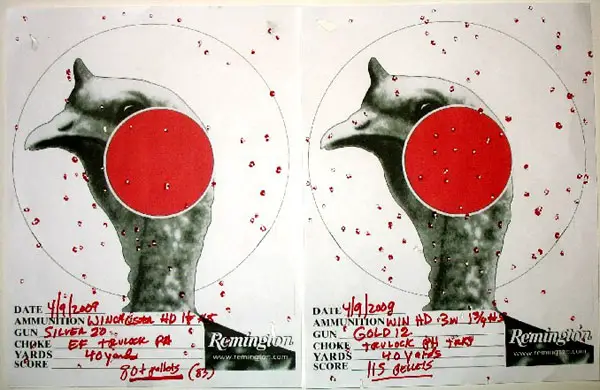|
Turkey Hunt Patterning Preparation The eternal question of what gun, load and choke tube is most suitable for turkey is a question with no universal answer. We have the �more is more� school of thinking that suggests that if 10 pellets into the head and neck of a turkey kills it, well, 50 pellets into the head and neck must make it deader. That�s one theory. Another approach is a bit more realistic. Understanding that it only takes one pellet with sufficient penetration in the right spot, we look for sufficient average pattern dispersion that ensures as close as possible to a 100% probability of a two-pellet lethal hit. We don�t look for this pattern on a one-time basis, we look for a sequence of five consecutive patterns that show what we want. Taking into consideration that turkeys are taken at various ranges, we pattern at the maximum range at which we intend to shoot. We also don�t focus entirely on a static outline of a turkey head; we look for reasonable pellet count above, below, to the left and to the right of our target to allow for turkey movement, range variances and the human factor. A preferred turkey pattern is a horribly bad wingshooting pattern, far too tight to eat what we shoot. The general goal of a wingshooting pattern is maximum effective pattern, not one that gimps our ability to cleanly take birds. While evenness of, say, a 20 inch pattern, particularly the fringe areas, is worth some consideration, it isn�t relevant to productive turkey popping. A typical patterning day around here includes half a dozen
shotguns, many more types of shells and countless choke tubes. Things don�t
always work as advertised, as marked and certainly not as expected. We did
settle on two combinations that we particularly liked; one a 12 gauge gun
shooting Winchester HD shells and the other a 20 gauge gun, also shooting
Winchester HD shells.
The pattern on the left is representative of what we liked from our Browning Silver 20 gauge gun, using an Extra Full Trulock Invector-plus Precision Hunter Extended choke with a 1-1/8 oz. load of Winchester HD #5 shot. We think Winchester is missing the boat by not offering this load with #6 HD shot. As the HD pellets are denser than lead, #6 HD is more than sufficient for 40 to 45 yard use and would substantially up the pellet count with no downside. We keep hoping; perhaps one day the folks at Olin will listen. Regardless, we were impressed that our 1-1/8 oz. 20 gauge load averaged 83 pellets into our 8-1/2 x 11 targets with the George Trulock PH EF extended choke. We tried a bit tight PH choke, a �TKY� with a .585 inch exit diameter. A few patterns gave us a better pellet count, but more gave us slightly less. We finally settled on the Extra Full tube (.595 exit diameter) as being more consistent overall. With our Browning Gold 12 gauge, the tighter �TKY� choke gave us better results, managing 115 #5 HD pellets into the target above. In this case, the exit diameter of the 12 gauge Invector Plus Trulock Precision Hunter tube is .670 inches. We can make a few generalizations from our pattern testing, with the cautionary note that all guns pattern differently, sometimes quite differently. While we had had extremely good results with Winchester HD loads to date, more payload does not always equal more pellets on target. Nor does a larger gauge always mean more pattern efficiency. Our 12 gauge Browning Gold did put more pellets on the target, but the 20 gauge patterned more efficiently. With the average 83 pellets from 20 gauge 1-1/8 oz. load, the shot count was increased by just over 55% by going to the 1-3/4 oz. 12 gauge load. We didn�t get 55% more hits on target, though. We improved, obviously, but the jump in pellet count averaged 38%, not commensurate with the increased pellet count (or recoil, for that matter). Thus, there are some diminishing returns evident in our results. Increased constriction is not linear to increased pattern percentage. Our 12 gauge has approximately .070 in. of constriction versus our more efficiently patterning 20 gauge with only half that constriction, at about .035 inch. As noted, more constriction in the 20 gauge sent patterns the other way. �Nobody knows nothing� (attributed to William Goldman) is a saying about Hollywood, but it is just as appropriately applied to shotgun patterns. Nobody knows nothing about nothing, until they decide to pattern individual guns, shells and choke tubes. That�s when twenty gauge guns might prove to be more efficient than 12 gauges and half the constriction might net you a more than previous assumptions have led you to believe. |
